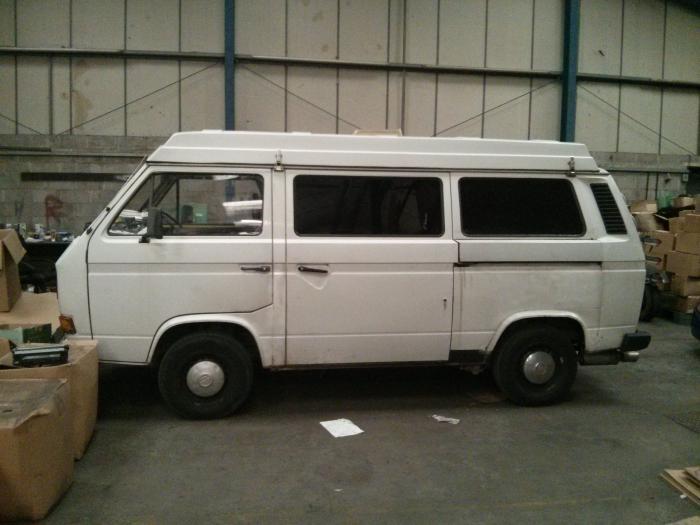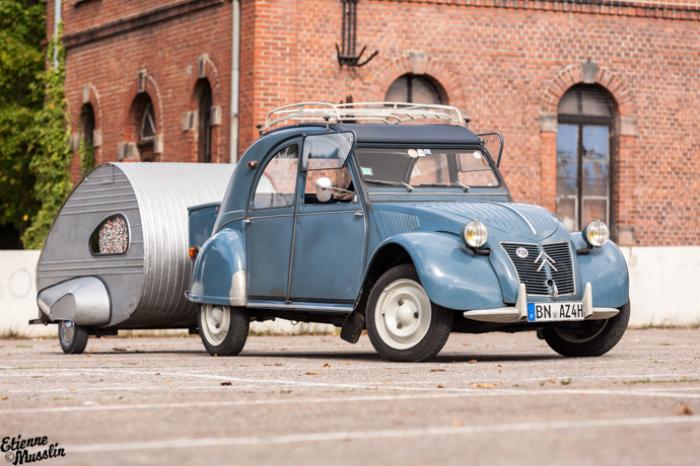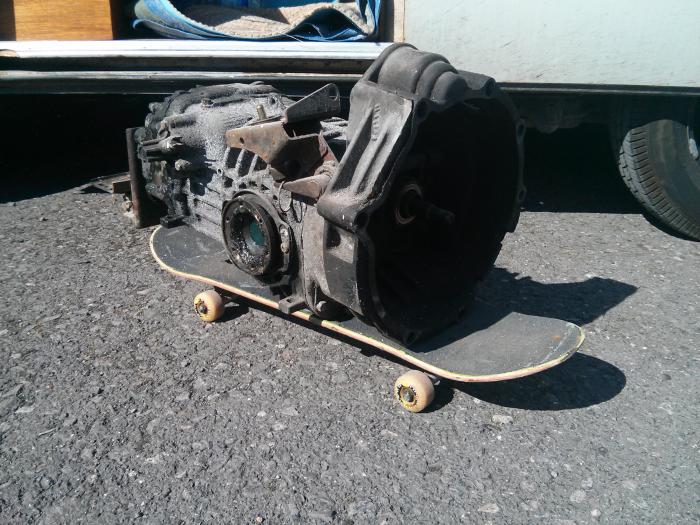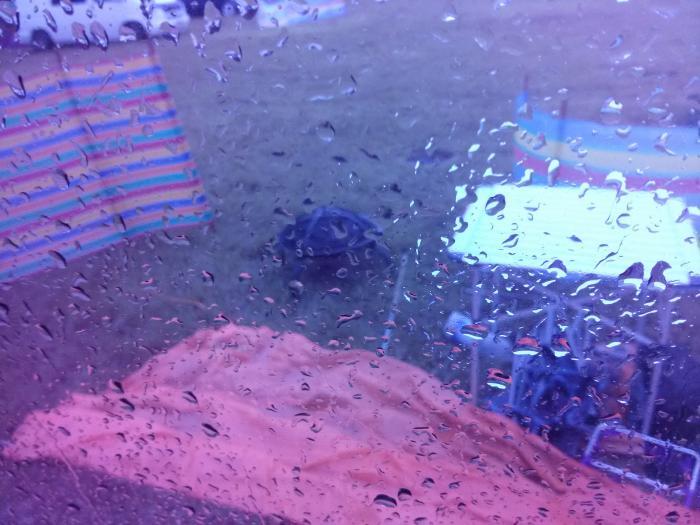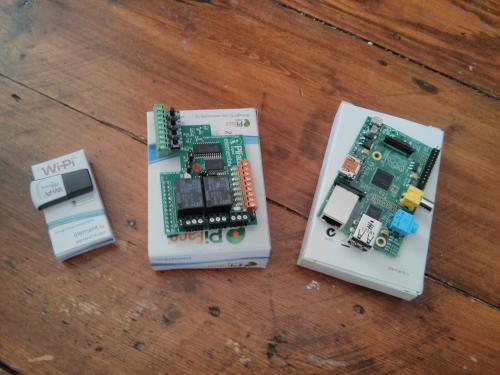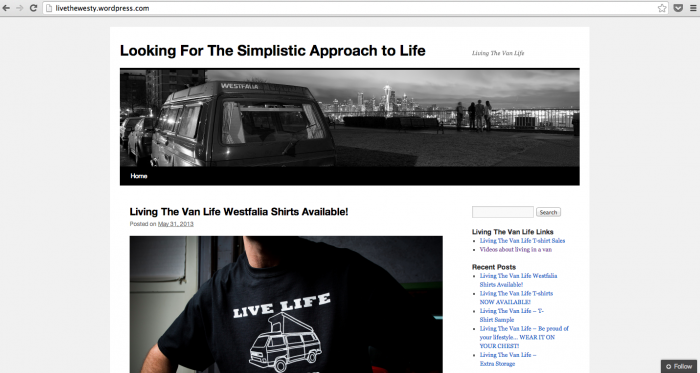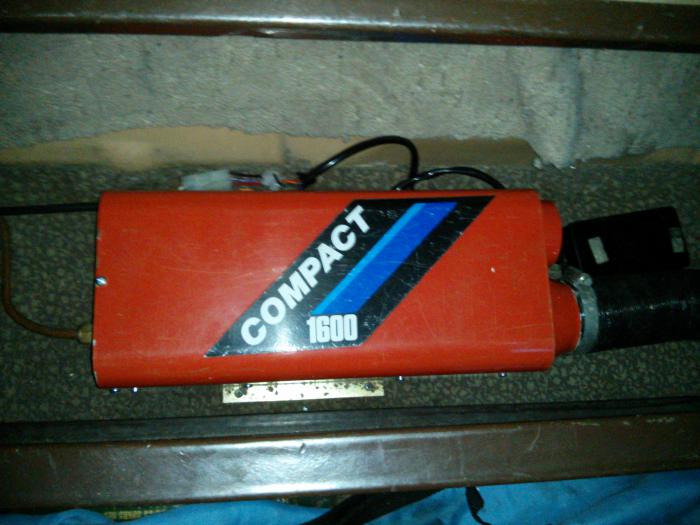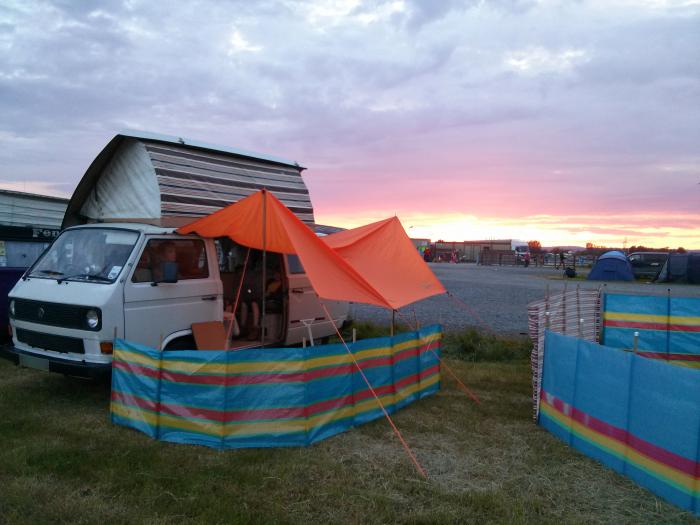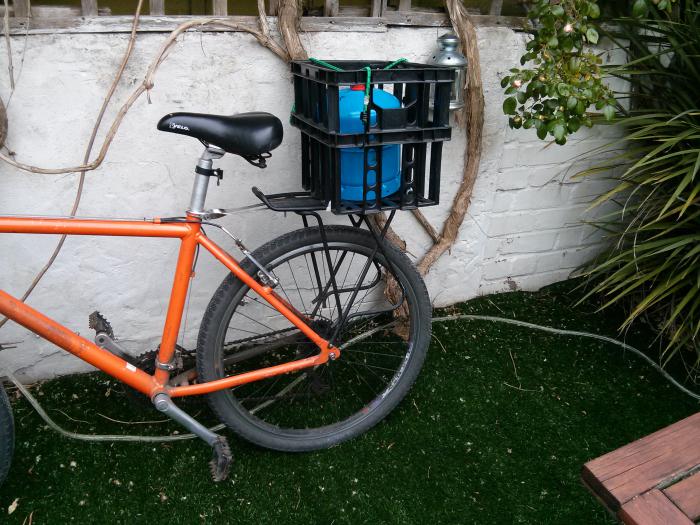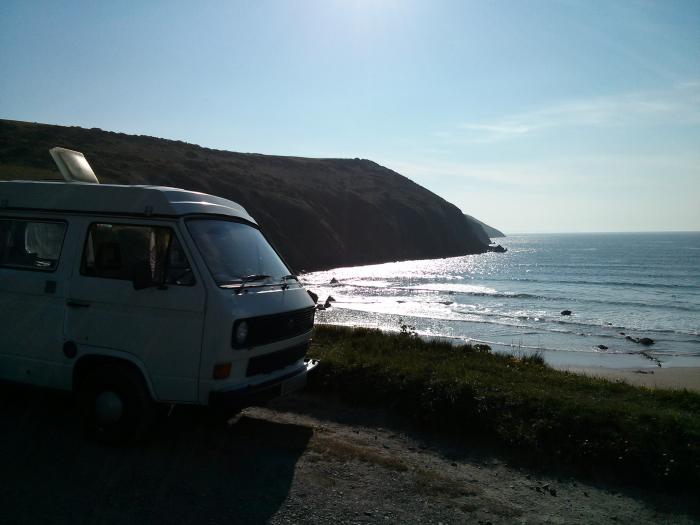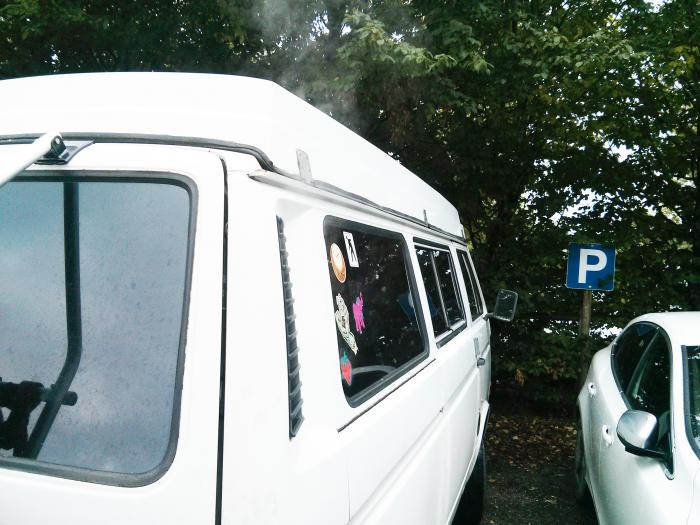
There’s a saying that people use after a successful trip in an old vehicle, something like: “I just did a 1000 mile trip and it didn’t miss a beat!”. At the end of July we did about 2000 miles round trip from Bristol down to southwest france and back and Rocky didn’t just miss a beat, but played the wrong song, pushed the drum kit off the stage and started to try to steal the guitars!
Before setting off to France with our new tdi engine conversion we covered 1500 miles in the UK without a hiccup, so I was confident that the engine was going to handle a similar distance on the continent. We decided to take the Plymouth – Roscoff ferry as we planned on travelling down the west side of france over a few days staying at Aires and municipal campsites to reach a family campsite in the Gers region.
On the approach to Plymouth, I noticed that the temperature gauge was a bit higher than usual, but it was a hot day, we were fully loaded and there were some steep hills. After the overnight ferry we headed off south, armed with the All the Aires in France book and a recommendation for a nice municipal site at Chatellerault. Once again, the temp gauge seemed to be a bit higher than usual (on test runs so far it had always sat mostly bang in the middle).
It was only when we came off the motorway and crawled through some roadworks near Cholet that things went seriously wrong. The temp gauge suddenly went to the top, the coolant light started flashing and we dived straight into a garden centre car park, switched off the engine and saw a plume of steam appear in the offside rear air vent.
One of the annoying things about a T25 is that to get to the engine when the van is fully loaded you need to remove the bikes from the rear rack, then all the stuff packed in the rear section to get to the engine lid. This was the first of many times I had to do this..
After letting the engine cool down a bit, I started looking for problems – it was clear that the coolant had vented off through the expansion tank pressure cap (the expansion tank is the one inside the engine bay – my tdi conversion doesn’t have the second top up tank behind the number plate). I couldn’t see any other leaks, so topped up the coolant and thought it would be a good idea to bleed the system. To do this you need to start the engine – but the starter motor was dead – nothing at all.
We had European breakdown cover, but I was determined only to use it as a last resort, as I know from experience that the first thing they are likely to do is tow your camper to a garage, where you won’t hear anything for days, leaving you homeless.
So I tried all the usual things – jump start from the leisure battery (ours is suitable for starting engines), running a live feed straight to the trigger wire on the solenoid (as taught to me by an AA man in Norfolk on our first road trip in Rocky). Nothing got any response, and the only thing I didn’t try at that point was the “screwdriver across the starter terminals” technique – I was a bit nervous about doing so, until I had consulted the forums to get a consensus whether that was a good idea.
As the engine was cool now, we managed to bump start Rocky, with my wife at the wheel and myself and our 10-year old kid pushing. I can confirm that a fully loaded T25 is a very heavy bus – if we weren’t on a slight slope I don’t think we would have managed it!
The temperature seemed stable so we decided to make some progress, and started picking out nearby “Aires de camping car” from the book. Just to clarify here – Aires de camping car are entirely different to the motorway aires – they are allocated spaces in towns and cities where motorhomes can overnight for a small charge, and luckily there are thousands of them across France.
We started overheating again on the slower roads, so stopped at a supermarket in Mauléon – parked on a slope, and I bought some more coolant and topped up again. Once again we had to bump start the van, but this time rather than heading straight off, I ran through the bleed procedure in case we had any airlocks in the system.
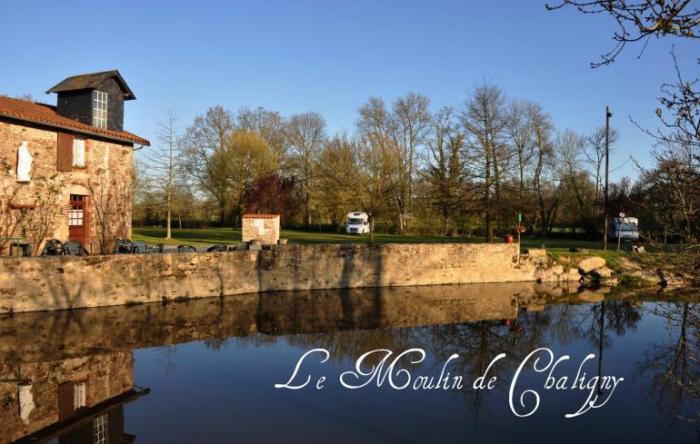
We headed for an Aire listed in the book, camping a Le Moulin de Chaligny near St. Amand sur Sevre, which turned out to be a really nice private campsite in the grounds of a bar/restaurant. Arriving in a cloud of steam, I picked a spot and parked up before enquiring if there was space, as I knew we weren’t going anywhere for a while! I would highly recommend it if you are passing by.
Luckily, the next morning the van started straight up, and has continued to do so every time since. My best theory is that the battery earth connection was bad and that the liberal soaking the battery and straps got during the first overheating episode was the cause?
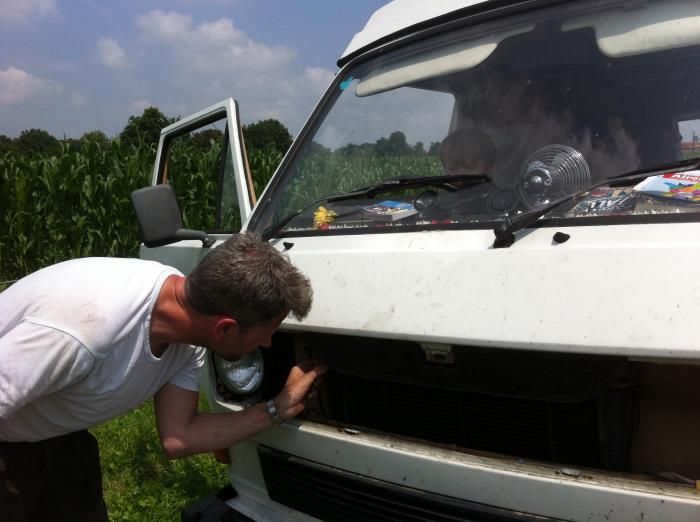
We spent the next couple of days at that Aire, with me mostly working on the van. – after consulting the forums and using the “phone a friend” option, I removed the thermostat (to allow coolant to always flow to the radiator), and extensively bled the system.
A few test runs showed that although the problem wasn’t fixed, the van behaved OK at higher revs. We filled up the diesel tank (I had a new tank fitted by Jeff’s VW shack before the trip as the old one would leak if you filled it to the top – although he problem was just a breather, the old tank was very corroded so a new tank was fitted). Once on the motorway the temp stayed stable, so we ploughed on down to the campsite we had booked at La Romieu in the Gers region. Once off the motorway the temp started to rise again, so we pulled over and let it cool down, and topped up and re-bled the system – frustratingly only a few miles from our destination.
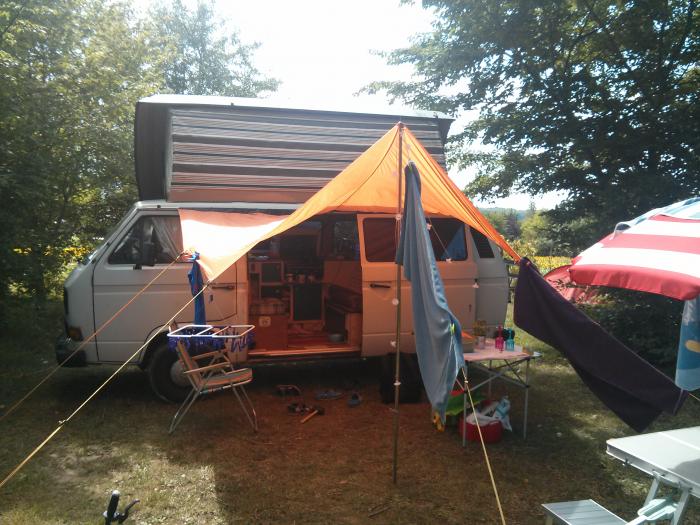
Safely pitched up on the campsite at La Romieu, the holiday continued, but short trips showed that the overheating issue hadn’t gone away. With the help of a French friend we tried to find a garage to take a look at it, but it seemed that every garage in the surrounding area was either closed or understaffed due to August holidays. We set up our tents (we bought enough camping gear with us this year, after our breakdown experience last year) and dropped Rocky off at the only open garage we could find. The next morning they phoned and said they didn’t understand old vw vans and could we please come and take it away (no charge)…
I was fairly sure at this point that the cause of the overheating was a faulty water pump. I’ll save you the suspense, and tell you that it definitely was. I didn’t have the tools with me to change a water pump, and having not changed one before, I was nervous of digging the hole deeper – taking a running but ill-behaving van and changing it to a non-running one with bits of engine missing. In retrospect, at that point I should have gone ahead and ordered one anyway, to be delivered to the campsite. In further retrospect, in preparation for the trip, the water pump should have been inspected and tested (I presumed I had a new one in there at the time of the engine swap, but there you go..).
I also connected a “chicken switch” to the radiator fan, so the fan could be switched on manually – I actually used one of my redundant mystery dashboard switches – on closer inspection I found some old wiring leading from near this switch down to the thermoswitch on the radiator, so i’m fairly sure this was the one-time purpose of the switch anyway!

I’m missing out the good bits of the holiday here – campsite was great and the area was beautiful, it was very social, hung out with old friends and made some new friends, having a temperamental van that we didn’t want to take far from the campsite forced us to stop rushing around and enjoy the company, pool, ice creams, cheap rose wine, games and conversation (mostly about the van on my part, I have to admit).

So at this point, the dilemma over the engine remained – call in the breakdown cover (i’m fairly sure they would just tow the van to the garage we had already tried) or struggle on. I then contacted the legendary John (aka “Sarran1955” -see his youtube channel here), as I knew he was only a few hours away in the Correze region, and had heard good things about him in the club 80-90 forum. It was arranged that we could visit him (if we could get there), camp on his land and he could help us out with tools and expertise.
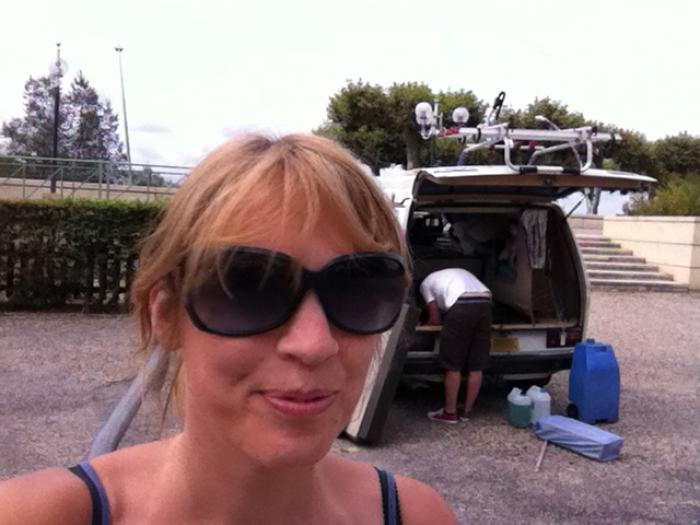
The trip to Sarran didn’t start well, as we were approaching the town of Agen, the van started to struggle on hills and the turbo whistle had become very loud – we pulled over, offloaded the bikes and unpacked the back for the umpteenth time, to discover one of the silicone hoses for the intercooler had popped off. As the engine was hot and the pipe slippery from oil residue it took a while to reattach. About a mile down the road, as we accelerated onto the motorway, the same thing happened again, luckily as we passed a convenient Aire. Second time around I did a better job of re-attaching it and did a few hard acceleration test runs around the Aire (to the disapproval of several picnicking families).
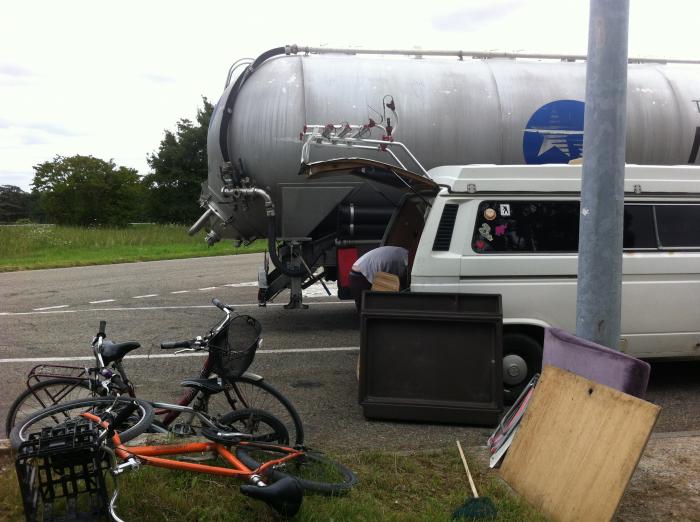
Once on the motorway the intercooler hose stayed on this time and the van stayed at a stable temperature, but would rise quickly once on slower moving roads. We managed to reach the town of Sarran without any further breakdowns and met up with John at the Musée du président Jacques Chirac in Sarran. We were soon pitched up in a spot that will be familiar to several club 80-90 members, overlooking the surrounding landscape.
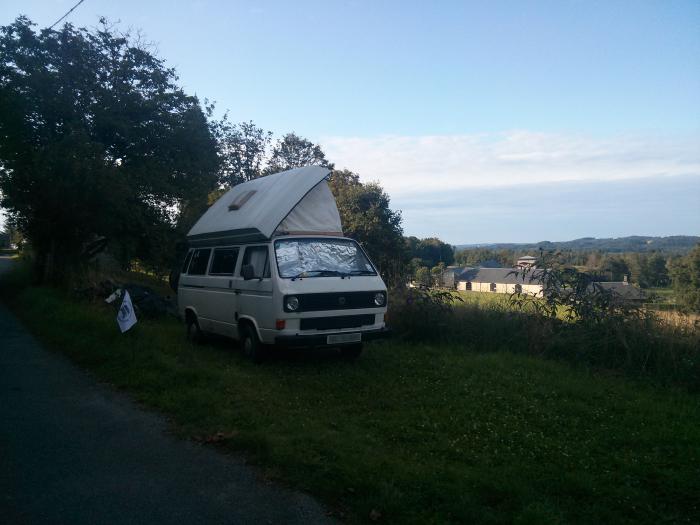
I’ve already spoiled the story and told you that the overheating was caused by a failed water pump, but at this point we weren’t sure of this, so spent a few days investigating some other possible causes – we bled and re-bled the system, checked that water was flowing around the system, checked that there weren’t any leaks allowing air to get in. The confusion was caused by the intermittent nature of the water pump failure, so several times we came to the (wrong) conclusion that the water pump must be ok – it turned freely and we could observe water circulating in the expansion tank (most of the time). At one point we though it was solved and even did some fun hill climbs following John in his air-cooled T25 up to Puy de Sarran, the highest point in the area, without overheating, only to overheat on a leisurely drive a few hours later. In the end we decided that the water pump should be replaced anyway, even if just to rule it out as the cause.
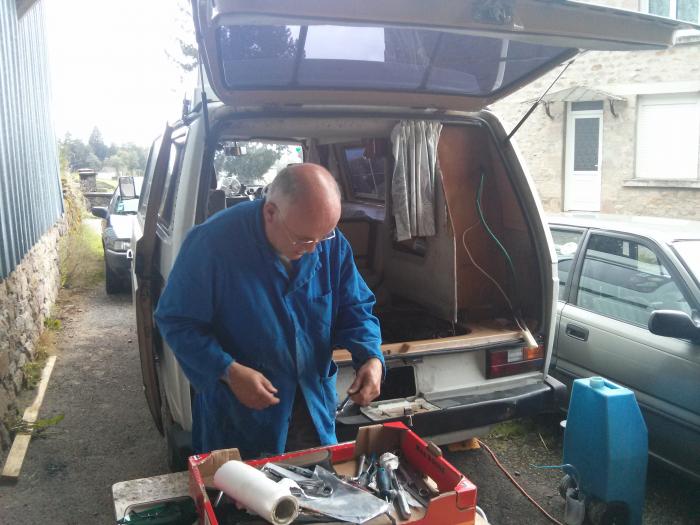
A nearby VW parts supplier was found, but to be sure we got the correct pump, he suggested we remove the existing water pump and bring it along for comparison. So we set about removing the water pump, but somewhere along the line deviated from the plan. I had read, and been told, that it is possible to remove the water pump on a 1z engine without disturbing the timing belt. It is possible, but you need to remove the whole assembly (including disconnecting the hoses). For the record (it’s easy when you know how!) to remove the water pump on a 1z engine without removing the timing belt:-
- disconnect the battery (for safety reasons)
- remove the auxiliary belt (rotate the tensioner arm with a wrench until the belt goes slack)
- remove the alternator, and the mount/bracket that it is bolted to.
- disconnect the hoses from the back of the water pump assembly (obviously coolant will go everywhere when you do this, so be prepared!)
- remove the four bolts/ studs on top of the water pump assembly
- you can then remove the assembly and detach the water pump and front plate from the housing
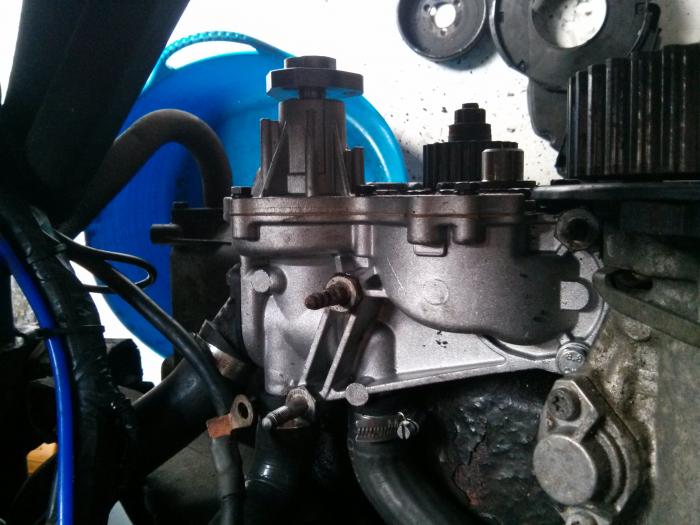
However, we missed some key info here and ended up removing the timing belt. If you remove the timing belt, the water pump and the front plate can be separated from the water pump housing without removing the alternator etc. As water pumps are usually replaced at the same time as the timing belt, most people do it that way, but be warned – fitting a timing belt is a tricky job and an engine can be seriously damaged if the timing is out.
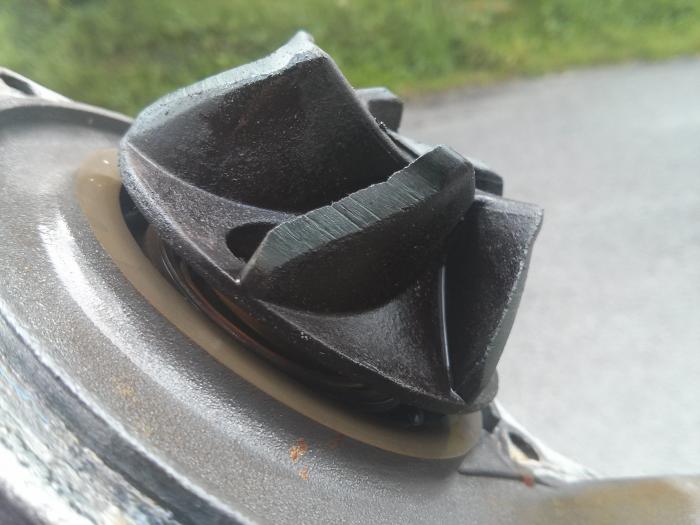
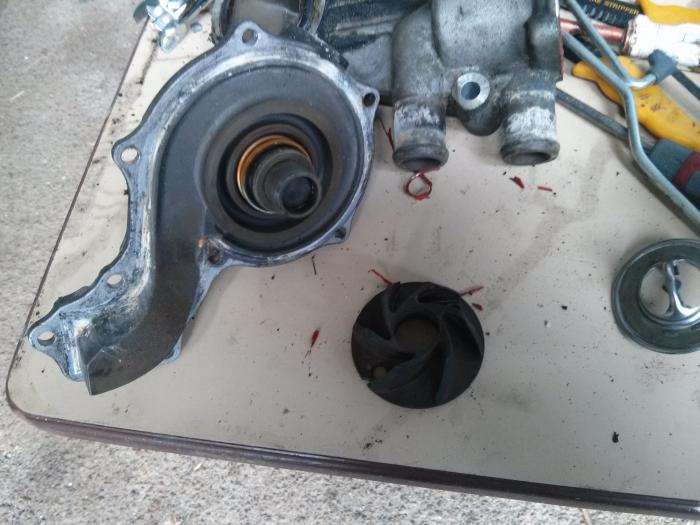
Once removed it was evident that there was a problem with the water pump – the plastic impeller showed signs of wear, so it must have been making contact with something, and we then noticed that the impeller could be rotated on the shaft (and easily removed, once out of the housing). This explained the intermittent nature of the overheating – sometimes the impeller would catch on the shaft and therefore be pumping correctly, other times it was slipping on the shaft and struggling to pump at all.
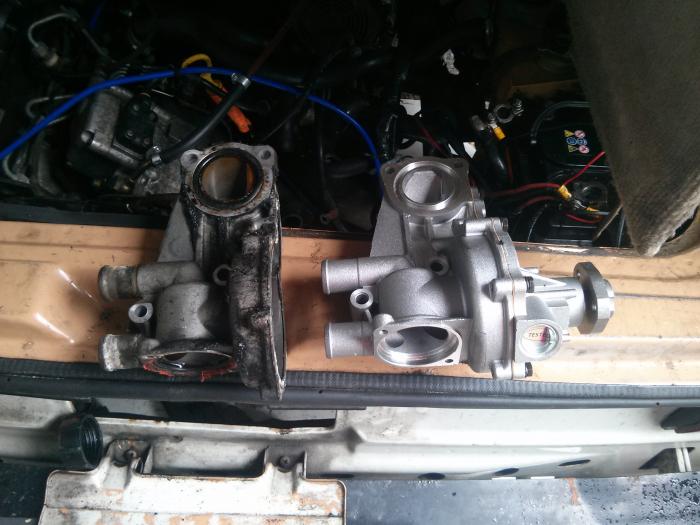
The water pump was replaced with a new one – the whole assembly, as this is what the supplier in the nearby town had on the shelf, it was a bank holiday in france the next day and we needed to make our way back to the UK sooner or later! I’ve since thought about this, and realised that a potential “get us home” fix if we couldn’t source a pump, could have been to araldite the impeller back onto the shaft.
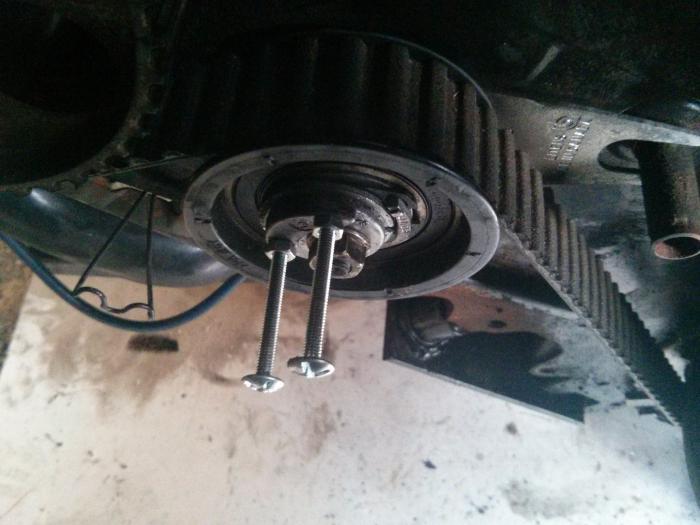
Next we fitted a new timing belt. We didn’t have the correct tools or time to source them. Notably missing was a timing belt tensioner tool. John came up with the ingenious solution of tapping (creating threads in) the holes in the tensioner so that we could screw in a couple of 4mm bolts. These bolts could be held by a wrench or pliers to rotate the tensioner and tension the belt.
The next challenge was timing – despite our best efforts to mark up the old belt and pulleys with paint marks, the timing was slightly out on first attempt, so that the engine wouldn’t start. We consulted the internet (youtube videos of processes such as these are gold-dust) and then went through the full timing set-up from scratch – we removed the rocker cover and locked the camshaft at Top Dead Centre (TDC), using a steel shim and some feeler gauges. We located TDC on the flywheel – my 1z conversion uses a JX flywheel and the TDC mark is actually on the clutch pressure plate – an arrow that can be found between two lugs. This can be spotted through the inspection hole on the bell housing, and needs to be lined up with a pointer on the housing. This can be locked in place by putting the van in gear.
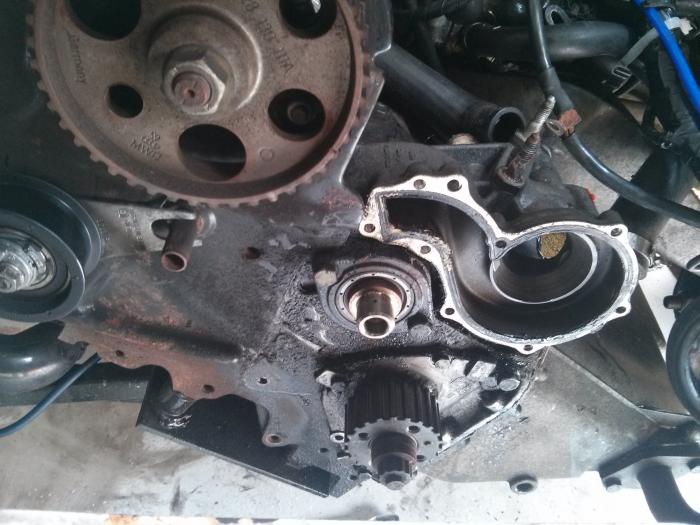
The bit that threw us was the fuel injection pump – this can be locked in the correct position using a tool pushed through the smallest hole on the pulley. We used a socket handle with tape to shim the difference in the size of the hole in the pulley and the corresponding hole in the plate behind. There was too much play, so first attempt again, the engine wouldn’t start. I should add here that before trying to start an engine with a new timing belt, always crank the engine over manually (using a socket on the crankshaft cog – take the engine out of gear and turn for two full revolutions), to check for any mechanical resistance – which would indicate something seriously out on the timing, probably leading to a very broken engine if you tried to start it like that.
Anyway, there is probably a whole blog post to be written on this process, and one that should be written by a mechanic rather than me! To cut a long story short, after a couple of false starts (fuel injection pump one tooth out) we succeeded in fitting and tensioning the new belt and the engine starting on the button as it should.
So then onto the test running – I was still running without a thermostat (to be replaced before running in cold UK winter temps), and the temperature now stayed right near the bottom of the gauge however it was driven, so we confidently concluded that the overheating issue was now solved! We could happily have stayed with John for much longer and got to know the area better in a more relaxed way in our now cool-running van, but we had already been there five days at this point and time and money constraints meant that we needed to start heading north.
John suggested a great municipal site at Spay, near Le Mans as a good “halfway point” and phoned ahead for us to check we could get in after hours. That leg of the journey was fantastic, as I started to relax into driving without checking the temp gauge every few seconds. The campsite was great, just as described and we relaxed into our penultimate night in France.
We had booked a very early morning eurotunnel crossing the day after next as it worked out much cheaper than travelling at peak times and at the weekend. On the trip to Calais we had to stop several times when the intercooler hose came off yet again, but the temperature stayed very low. On arriving at Eurotunnel terminal, the machine offered us a midnight crossing at no extra charge, so rather then sleeping in the camper in the carpark as planned, we had only a short wait before boarding the shuttle train.
We then drove back to Bristol through the early hours without incident and parked up at about 4am, and spent our first night in a proper bed in nearly a month!
Ironically back in the UK Rocky is now behaving perfectly – I took some time to clean up and properly clamp the intercooler hoses, and tighten the mounting. I decided to take it off the road for a few months to give the body work some TLC and sort out a few other bits and pieces in time for spring. I don’t really want to take it off the road for the whole winter, but time and money constraints mean that I don’t have much choice, so Rocky us now resting up in a friend’s warehouse for the winter.
